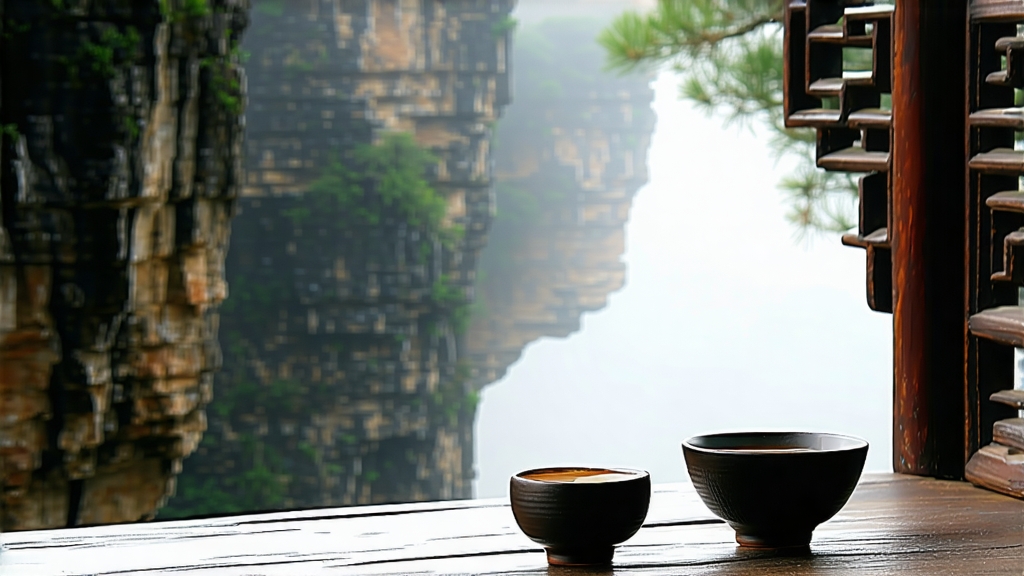
High above the winding Jiuqu Stream, where the Wuyi Range thrusts its granite shoulders into the moist Fujian sky, grows the most mythologized oolong on earth—Da Hong Pao, literally “Big Red Robe.” To understand this tea is to step into a tapestry of imperial edicts, scholarly pilgrimages, and living cliff-side horticulture that has survived six centuries of typhoons, wars, and market frenzies. International drinkers often meet Da Hong Pao as a dark, cocoa-scented liquor in a tiny cup, yet every sip carries the mineral breath of those nearly vertical rock gardens, the snap of pine charcoal, and the quiet discipline of artisans who still refuse to rush a single turn of the leaf.
Origin Myth and Documented History
Folklore tells of a Ming-dynasty scholar on his way to the capital exams who collapsed with fever in the Wuyi valley. Monks from the Tianxin Temple brewed leaves plucked from four stunted bushes clinging to a crack in the cliff; the traveler revived, passed the exams with top honors, and returned in triumph, draping his own crimson imperial robe over the bushes to honor their life-saving power. Whether or not the robe ever fluttered against that granite, official Ming court records (1368-1644) already list “Yan Cha” (rock tea) as tribute, and Qing-era tax scrolls quantify tea bricks bartered by monks for temple land. By the early 20th century, merchants in Xingcun port were exporting “Red Robe” to Southeast Asia, where miners in Malaya would pay an entire day’s wage for an ounce, convinced the tea dissolved the silica dust in their lungs. Thus myth and commerce braided together, turning four mother trees into a national treasure.
Terroir: Why Rocks Matter
UNESCO lists the 60-kilometer Wuyi gorge as a World Heritage site for its biodiversity, but tea growers venerate it for a more intimate geology. Volcanic tuff and weathered granite decompose into a shallow, fast-draining grit the locals call “rock bone.” With so little soil, tea roots plunge meters deep, mining potassium, magnesium, and a trace of copper that translates into a tingling, metallic finish the Chinese describe as “yan yun”—rock rhyme. Morning mists rise from the stream, refracting sunlight into a soft, diffused glow that slows photosynthesis, thickens cell walls, and concentrates aromatic compounds. Night temperatures drop sharply, locking those volatiles in place. No other oolong terroir replicates this diurnal shock on mineral bedrock, which is why Da Hong Pao grown even ten kilometers outside the core park lacks the lingering limestone snap that connoisseurs chase.
Garden Genetics and the Clone Family
The original mother trees—numbered 1, 2, 3, and 4—still survive on a ledge called Jiulong Ke, guarded by cameras and a chain-link fence. Cuttings taken in the 1960s produced asexually propagated offspring known as “pure-line” Da Hong Pao, today comprising less than 0.3 % of market volume. Far more common are “blended” versions that marry pure-line cuttings with other Wuyi cultivars such as Rou Gui (cassia) and Shui Xian (narcissus) to reconstruct the mother tree profile. A third category, “named-clone,” highlights single outstanding bushes—Que She (Sparrow Tongue), Qi Dan (Strange Dan)—each expressing a facet of the original: Que She leans floral, Qi Dan amplifies dark honey. Knowing which style you hold changes both brewing and expectation; a blend may need a longer rinse to awaken disparate leaves, whereas a pure-line can be coaxed open with cooler water to protect its subtlety.
Craft: The Eight Stages That Tame Granite into Fragrance
- Picking: Only the middle three leaves are plucked when the morning dew has lifted but before the sun turns fierce, usually between late April and early May.
- Wilting: Leaves are spread on bamboo screens in a shaded corridor where mountain breeze dehydrates them just enough to soften cell walls without oxidizing edges.
- Shaking: Every hour the tea master lifts the screens and gives them a rhythmic shake, bruising peripheral cells so oxygen can flirt with polyphenols. This “green vs. red” battle—green centers, rust-red rims—